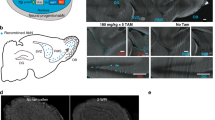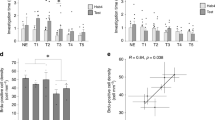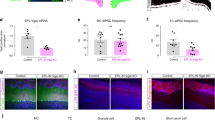Abstract
Thousand of local interneurons reach the olfactory bulb of adult rodents every day, but the functional effect of this process remains elusive. By selectively expressing channelrhodopsin in postnatal-born mouse neurons, we found that their activation accelerated difficult odor discrimination learning and improved memory. This amelioration was seen when photoactivation occurred simultaneously with odor presentation, but not when odor delivery lagged by 500 ms. In addition, learning was facilitated when light flashes were delivered at 40 Hz, but not at 10 Hz. Both in vitro and in vivo electrophysiological recordings of mitral cells revealed that 40-Hz stimuli produced enhanced GABAergic inhibition compared with 10-Hz stimulation. Facilitation of learning occurred specifically when photoactivated neurons were generated during adulthood. Taken together, our results demonstrate an immediate causal relationship between the activity of adult-born neurons and the function of the olfactory bulb circuit.
This is a preview of subscription content, access via your institution
Access options
Subscribe to this journal
Receive 12 print issues and online access
$209.00 per year
only $17.42 per issue
Buy this article
- Purchase on Springer Link
- Instant access to full article PDF
Prices may be subject to local taxes which are calculated during checkout






Similar content being viewed by others
References
Breton-Provencher, V., Lemasson, M., Peralta, M.R. & Saghatelyan, A. Interneurons produced in adulthood are required for the normal functioning of the olfactory bulb network and for the execution of selected olfactory behaviors. J. Neurosci. 29, 15245–15257 (2009).
Moreno, M.M. et al. Olfactory perceptual learning requires adult neurogenesis. Proc. Natl. Acad. Sci. USA 106, 17980–17985 (2009).
Rochefort, C., Gheusi, G., Vincent, J.D. & Lledo, P.M. Enriched odor exposure increases the number of newborn neurons in the adult olfactory bulb and improves odor memory. J. Neurosci. 22, 2679–2689 (2002).
Lazarini, F. et al. Cellular and behavioral effects of cranial irradiation of the subventricular zone in adult mice. PLoS ONE 4, e7017 (2009).
Sultan, S. et al. Learning-dependent neurogenesis in the olfactory bulb determines long-term olfactory memory. FASEB J. 24, 2355–2363 (2010).
Enwere, E. et al. Aging results in reduced epidermal growth factor receptor signaling, diminished olfactory neurogenesis, and deficits in fine olfactory discrimination. J. Neurosci. 24, 8354–8365 (2004).
Mandairon, N. et al. Neurogenic correlates of an olfactory discrimination task in the adult olfactory bulb. Eur. J. Neurosci. 24, 3578–3588 (2006).
Alonso, M. et al. Olfactory discrimination learning increases the survival of adult-born neurons in the olfactory bulb. J. Neurosci. 26, 10508–10513 (2006).
Mouret, A., Lepousez, G., Gras, J., Gabellec, M.M. & Lledo, P.M. Turnover of newborn olfactory bulb neurons optimizes olfaction. J. Neurosci. 29, 12302–12314 (2009).
Sakamoto, M. et al. Continuous neurogenesis in the adult forebrain is required for innate olfactory responses. Proc. Natl. Acad. Sci. USA 108, 8479–8484 (2011).
Valley, M.T., Mullen, T.R., Schultz, L.C., Sagdullaev, B.T. & Firestein, S. Ablation of mouse adult neurogenesis alters olfactory bulb structure and olfactory fear conditioning. Front. Neurosci. 3, 51 (2009).
Yokoi, M., Mori, K. & Nakanishi, S. Refinement of odor molecule tuning by dendrodendritic synaptic inhibition in the olfactory bulb. Proc. Natl. Acad. Sci. USA 92, 3371–3375 (1995).
Lledo, P.M. & Lagier, S. Adjusting neurophysiological computations in the adult olfactory bulb. Semin. Cell Dev. Biol. 17, 443–453 (2006).
Cleland, T.A. Early transformations in odor representation. Trends Neurosci. 33, 130–139 (2010).
Shepherd, G.M., Chen, W.R., Willhite, D., Migliore, M. & Greer, C.A. The olfactory granule cell: from classical enigma to central role in olfactory processing. Brain Res. Rev. 55, 373–382 (2007).
Matsutani, S. & Yamamoto, N. Centrifugal innervation of the mammalian olfactory bulb. Anat. Sci. Int. 83, 218–227 (2008).
Mouret, A., Murray, K. & Lledo, P.M. Centrifugal drive onto local inhibitory interneurons of the olfactory bulb. Ann. NY Acad. Sci. 1170, 239–254 (2009).
Abraham, N.M. et al. Maintaining accuracy at the expense of speed: stimulus similarity defines odor discrimination time in mice. Neuron 44, 865–876 (2004).
Abraham, N.M. et al. Synaptic inhibition in the olfactory bulb accelerates odor discrimination in mice. Neuron 65, 399–411 (2010).
Murthy, V.N. Olfactory maps in the brain. Annu. Rev. Neurosci. 34, 233–258 (2011).
Lazarini, F. & Lledo, P.M. Is adult neurogenesis essential for olfaction? Trends Neurosci. 34, 20–30 (2011).
Bardy, C., Alonso, M., Bouthour, W. & Lledo, P.M. How, when, and where new inhibitory neurons release neurotransmitters in the adult olfactory bulb. J. Neurosci. 30, 17023–17034 (2010).
Tan, J., Savigner, A., Ma, M. & Luo, M. Odor information processing by the olfactory bulb analyzed in gene-targeted mice. Neuron 65, 912–926 (2010).
Cang, J. & Isaacson, J.S. In vivo whole-cell recording of odor-evoked synaptic transmission in the rat olfactory bulb. J. Neurosci. 23, 4108–4116 (2003).
Isaacson, J.S. & Strowbridge, B.W. Olfactory reciprocal synapses: dendritic signaling in the CNS. Neuron 20, 749–761 (1998).
Dietz, S.B. & Murthy, V.N. Contrasting short-term plasticity at two sides of the mitral-granule reciprocal synapse in the mammalian olfactory bulb. J. Physiol. (Lond.) 569, 475–488 (2005).
Rinberg, D., Koulakov, A. & Gelperin, A. Sparse odor coding in awake behaving mice. J. Neurosci. 26, 8857–8865 (2006).
Gheusi, G. et al. Importance of newly generated neurons in the adult olfactory bulb for odor discrimination. Proc. Natl. Acad. Sci. USA 97, 1823–1828 (2000).
Imayoshi, I. et al. Roles of continuous neurogenesis in the structural and functional integrity of the adult forebrain. Nat. Neurosci. 11, 1153–1161 (2008).
Linster, C. et al. Perceptual correlates of neural representations evoked by odorant enantiomers. J. Neurosci. 21, 9837–9843 (2001).
Dhawale, A.K., Hagiwara, A., Bhalla, U.S., Murthy, V.N. & Albeanu, D.F. Non-redundant odor coding by sister mitral cells revealed by light addressable glomeruli in the mouse. Nat. Neurosci. 13, 1404–1412 (2010).
Stopfer, M., Bhagavan, S., Smith, B.H. & Laurent, G. Impaired odor discrimination on desynchronization of odor-encoding neural assemblies. Nature 390, 70–74 (1997).
Mwilaria, E.K., Ghatak, C. & Daly, K.C. Disruption of GABAA in the insect antennal lobe generally increases odor detection and discrimination thresholds. Chem. Senses 33, 267–281 (2008).
Kay, L.M. & Stopfer, M. Information processing in the olfactory systems of insects and vertebrates. Semin. Cell Dev. Biol. 17, 433–442 (2006).
Doucette, W. & Restrepo, D. Profound context-dependent plasticity of mitral cell responses in olfactory bulb. PLoS Biol. 6, e258 (2008).
Doucette, W. et al. Associative cortex features in the first olfactory brain relay station. Neuron 69, 1176–1187 (2011).
Chapuis, J. & Wilson, D.A. Bidirectional plasticity of cortical pattern recognition and behavioral sensory acuity. Nat. Neurosci. 15, 155–161 (2012).
Uchida, N. & Mainen, Z.F. Speed and accuracy of olfactory discrimination in the rat. Nat. Neurosci. 6, 1224–1229 (2003).
Rinberg, D., Koulakov, A. & Gelperin, A. Speed-accuracy tradeoff in olfaction. Neuron 51, 351–358 (2006).
Nissant, A., Bardy, C., Katagiri, H., Murray, K. & Lledo, P.M. Adult neurogenesis promotes synaptic plasticity in the olfactory bulb. Nat. Neurosci. 12, 728–730 (2009).
Mandairon, N. & Linster, C. Odor perception and olfactory bulb plasticity in adult mammals. J. Neurophysiol. 101, 2204–2209 (2009).
Laurent, G. Olfactory network dynamics and the coding of multidimensional signals. Nat. Rev. Neurosci. 3, 884–895 (2002).
Franks, K.M. & Isaacson, J.S. Strong single-fiber sensory inputs to olfactory cortex: implications for olfactory coding. Neuron 49, 357–363 (2006).
Mouret, A. et al. Learning and survival of newly generated neurons: when time matters. J. Neurosci. 28, 11511–11516 (2008).
Wilson, D.A. & Stevenson, R.J. Olfactory perceptual learning: the critical role of memory in odor discrimination. Neurosci. Biobehav. Rev. 27, 307–328 (2003).
Mandairon, N., Stack, C., Kiselycznyk, C. & Linster, C. Broad activation of the olfactory bulb produces long-lasting changes in odor perception. Proc. Natl. Acad. Sci. USA 103, 13543–13548 (2006).
Koulakov, A.A. & Rinberg, D. Sparse incomplete representations: a potential role of olfactory granule cells. Neuron 72, 124–136 (2011).
Sahay, A., Wilson, D.A. & Hen, R. Pattern separation: a common function for new neurons in hippocampus and olfactory bulb. Neuron 70, 582–588 (2011).
Lepousez, G., Alonso, M., Wagner, S., Gallarda, B.W. & Lledo, P.-M. Selective viral transduction of adult-born olfactory neurons for chronic in vivo optogenetic stimulation. J. Vis. Exp. published online, doi:10.3791/3380 (28 December 2011).
Alonso, M. et al. Turning astrocytes from the rostral migratory stream into neurons: a role for the olfactory sensory organ. J. Neurosci. 28, 11089–11102 (2008).
Neville, K.R. & Haberly, L.B. Beta and gamma oscillations in the olfactory system of the urethane-anesthetized rat. J. Neurophysiol. 90, 3921–3930 (2003).
Acknowledgements
We thank G. Gheusi for his advice regarding the use of olfactometers, L. Petreanu for the manipulation of the LEDs during behavioral experiments, K. Murray and N. Maffey for technical assistance, and M. Valley and G. Gheusi for their critical reading of the manuscript. We thank the ENP Network for Viral Transfer for viral vector production. This work was supported by NovalisTaitbout, the Letten Foundation, the Foundation pour la Recherche Medical, the Agence Nationale de la Recherche (ANR-BLAN-SVSE4-LS-110624 and ANR-09-NEUR-004 in the frame of “ERA-NET NEURON” of FP7 program by the European Commission).
Author information
Authors and Affiliations
Contributions
M.A. and P.-M.L. designed the experiments, discussed the results and wrote the manuscript. M.A. performed surgery, behavioral experiments and analyzed data. G.L. designed, performed and analyzed in vivo electrophysiology recordings. S.W. design olfactomers and light-stimulation devices. C.B. performed and analyzed in vitro electrophysiology recordings. M.-M.G. performed immunohistochemistry and N.T. designed the database for behavioral analysis.
Corresponding author
Ethics declarations
Competing interests
The authors declare no competing financial interests.
Supplementary information
Supplementary Text and Figures
Supplementary Figures 1–8 (PDF 4213 kb)
Supplementary Video 1
Photostimulation of adult-born neurons during olfactory discrimination learning. (AVI 10250 kb)
Rights and permissions
About this article
Cite this article
Alonso, M., Lepousez, G., Wagner, S. et al. Activation of adult-born neurons facilitates learning and memory. Nat Neurosci 15, 897–904 (2012). https://doi.org/10.1038/nn.3108
Received:
Accepted:
Published:
Issue Date:
DOI: https://doi.org/10.1038/nn.3108
This article is cited by
-
Distinct forms of structural plasticity of adult-born interneuron spines in the mouse olfactory bulb induced by different odor learning paradigms
Communications Biology (2024)
-
Seed-induced Aβ deposition alters neuronal function and impairs olfaction in a mouse model of Alzheimer’s disease
Molecular Psychiatry (2022)
-
Extrinsic neuromodulation in the rodent olfactory bulb
Cell and Tissue Research (2021)
-
Odor hedonics coding in the vertebrate olfactory bulb
Cell and Tissue Research (2021)
-
Intranasal Insulin Enhances Intracerebroventricular Streptozotocin–Induced Decrease in Olfactory Discriminative Learning via Upregulation of Subventricular Zone–Olfactory Bulb Neurogenesis in the Rat Model
Molecular Neurobiology (2021)



